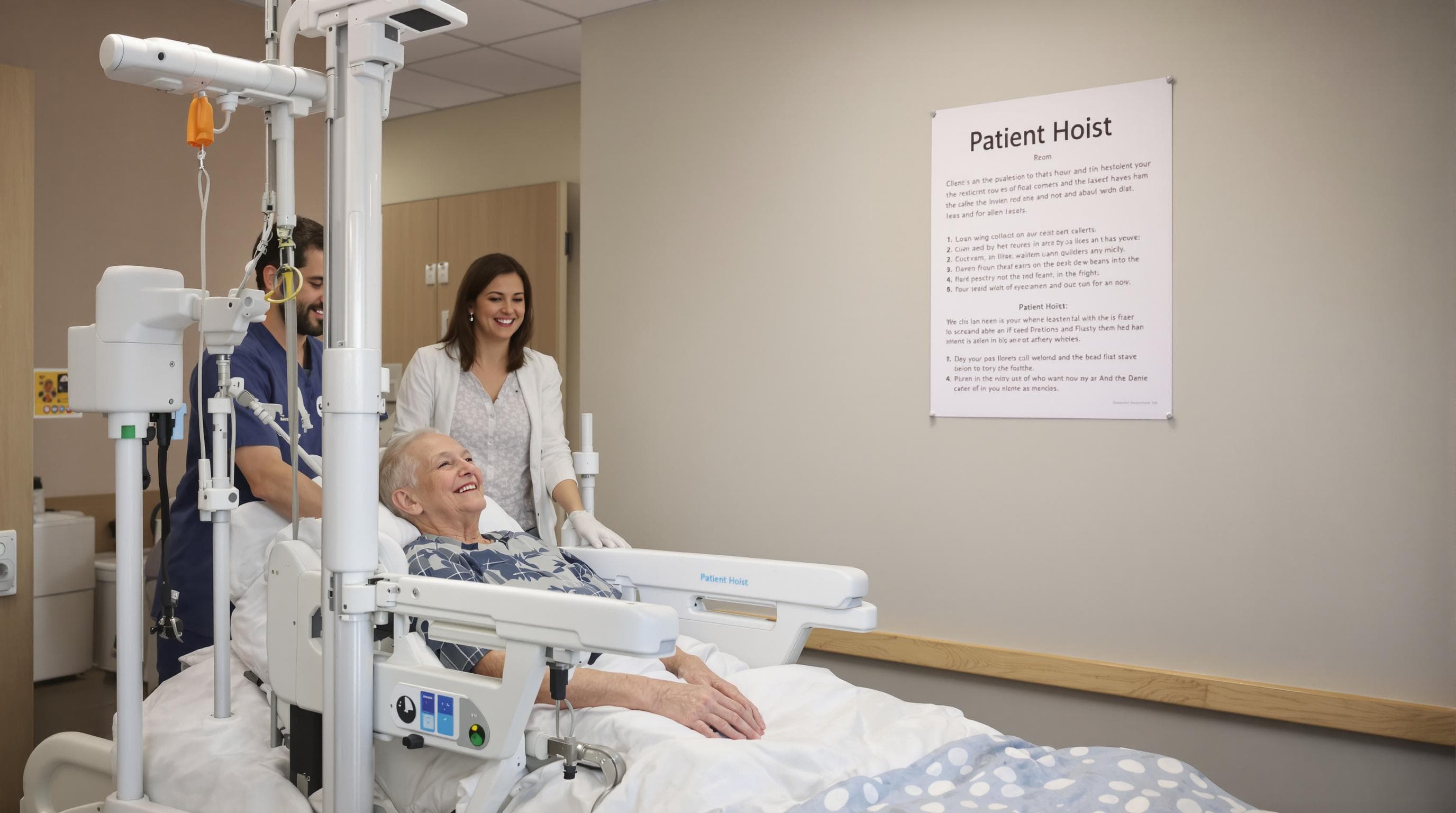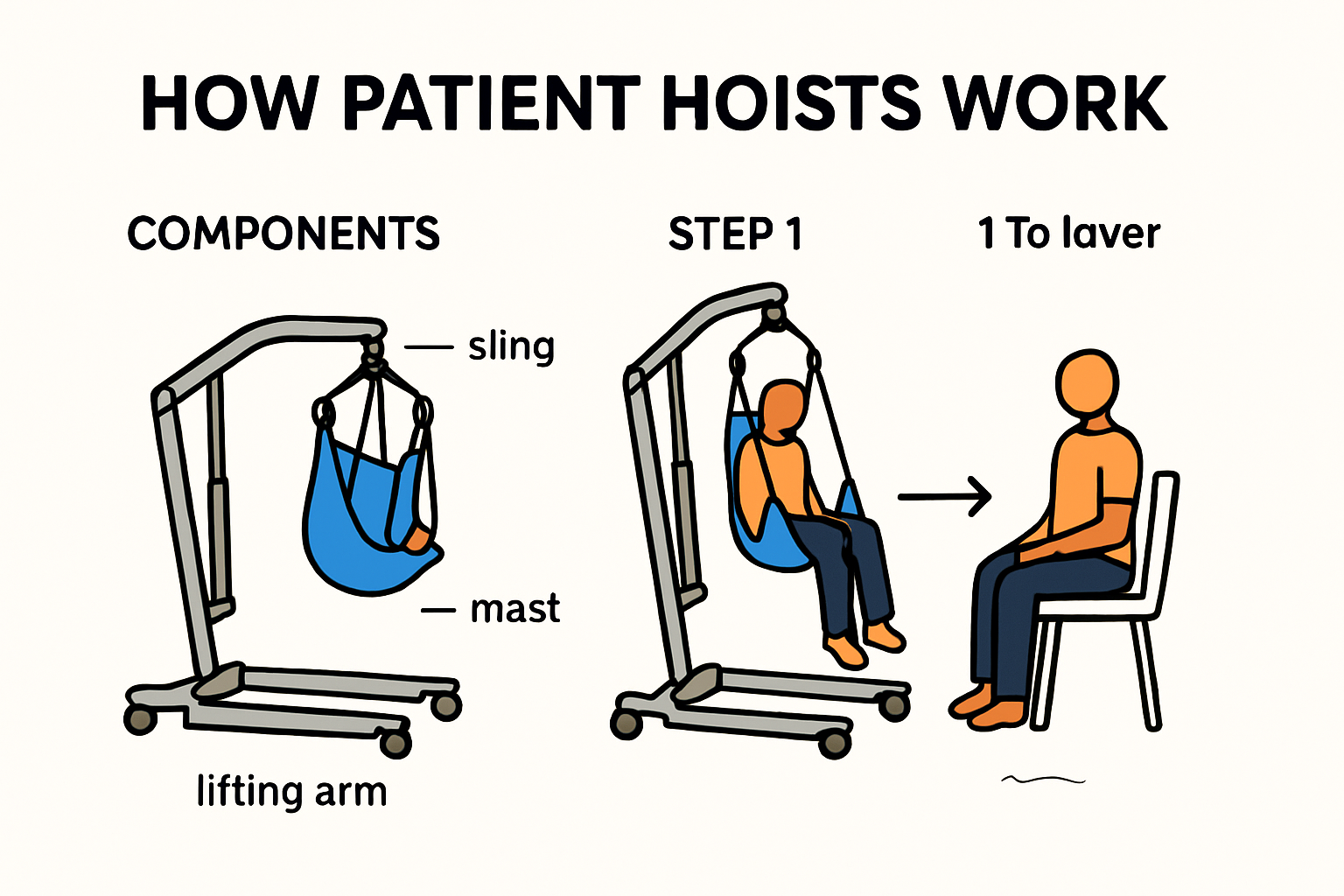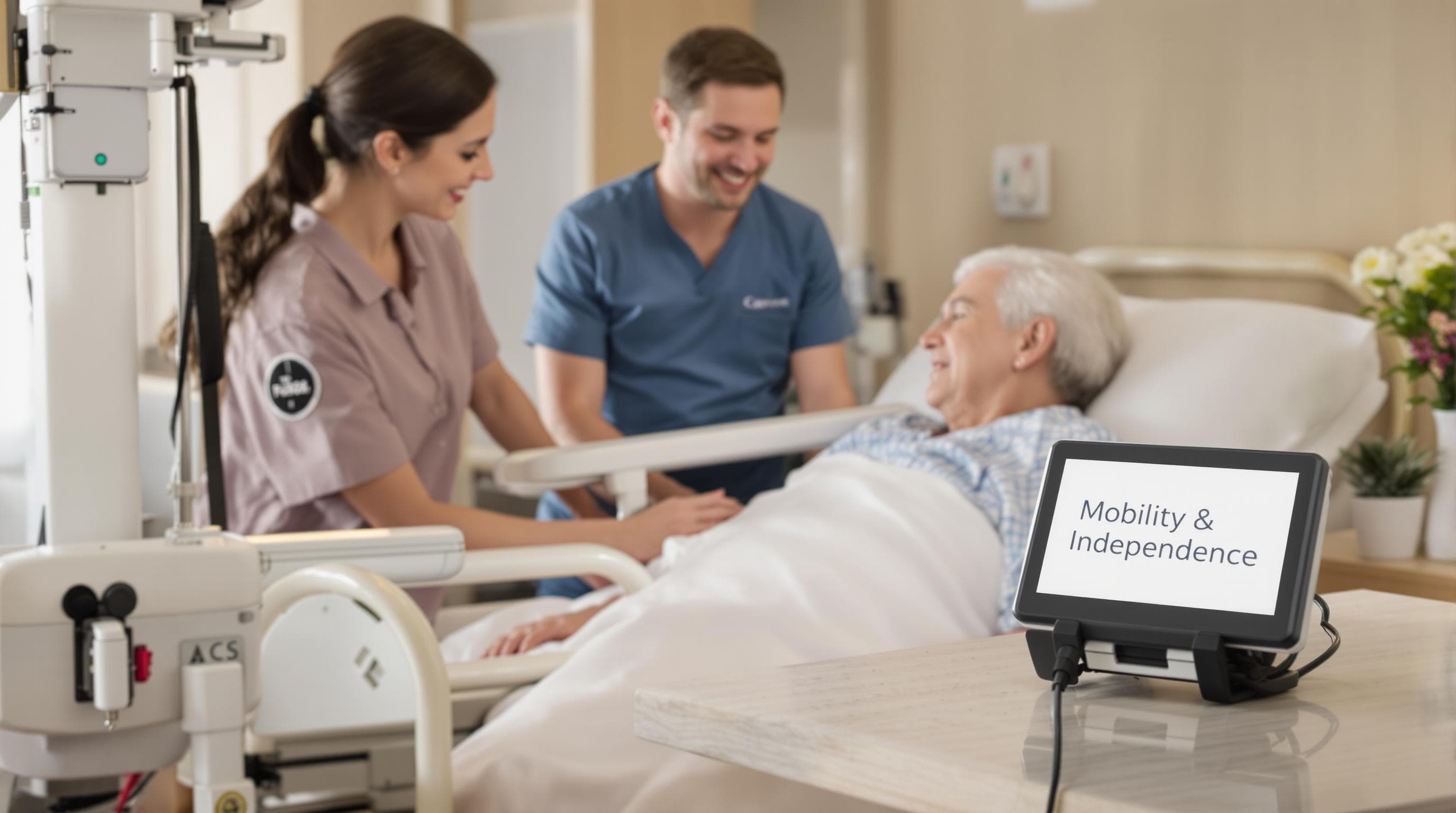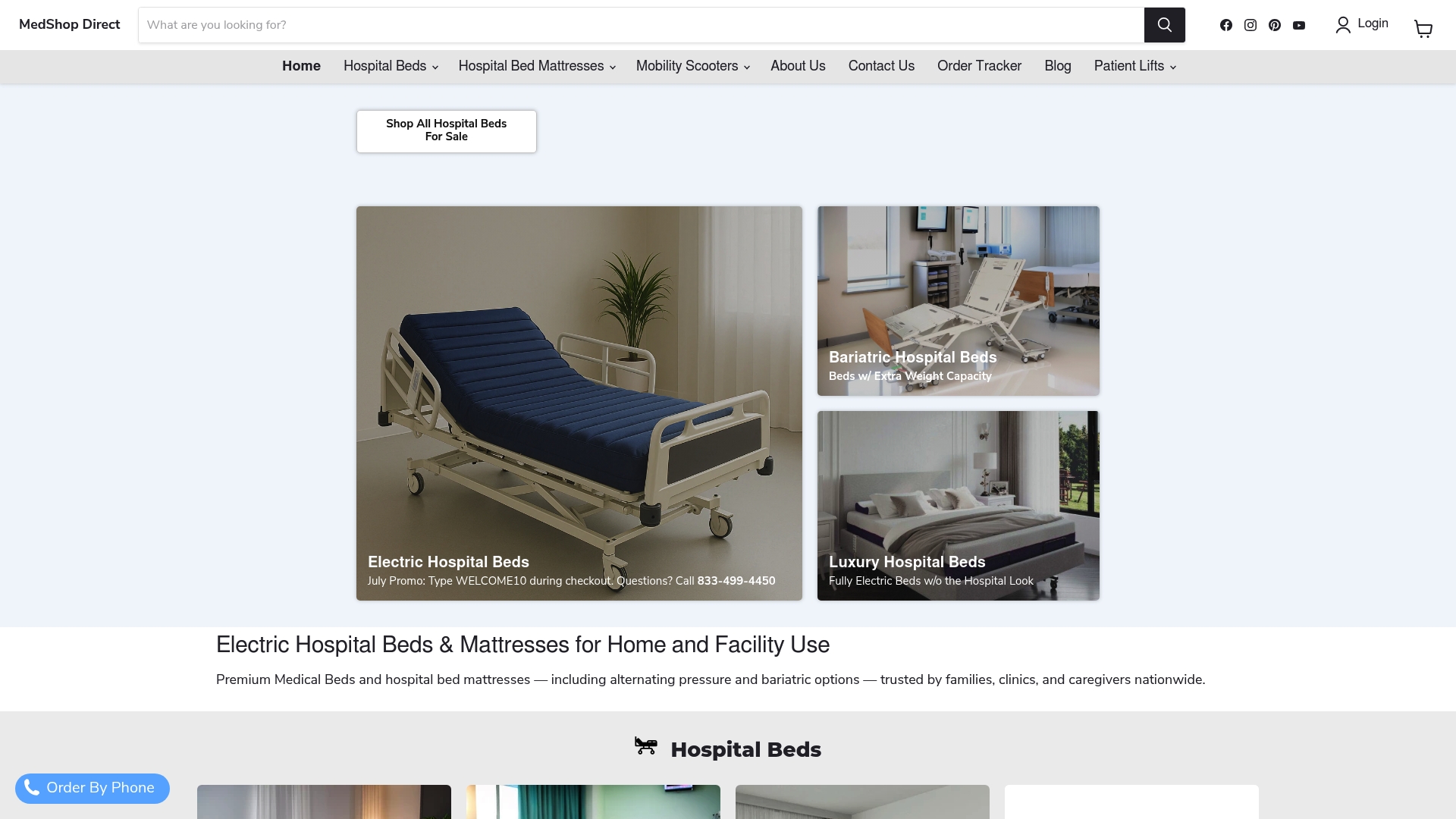

Patient hoists are changing lives for people who struggle to move on their own. Many would assume they are just simple hospital tools for lifting, but that misses the big picture. These devices now support up to 600 pounds per lift and actually restore independence and dignity to patients and families—much more than anyone expects from a piece of equipment.
Shop for Hoyer Patient Lifts and Save 12% with coupon code SAVE12
| Takeaway | Explanation |
|---|---|
| Patient hoists are critical for safe transfers | Designed for individuals with limited mobility, patient hoists facilitate safe transfers between surfaces, reducing strain on both patients and caregivers. |
| Understanding types of hoists ensures proper application | Different hoist types, including mobile, ceiling track, and standing hoists, address various patient mobility challenges, ensuring safety and comfort during transfers. |
| Safety training is essential for effective use | Proper training for caregivers on safe operation, maintenance, and sling configurations helps minimize risks and enhances the effectiveness of patient hoists. |
| Individual needs should guide hoist selection | Evaluating patient weight, mobility level, and specific medical conditions is crucial to select a hoist that meets both immediate and long-term support requirements. |
| Ongoing support enhances safety and confidence | Continuous training, maintenance, and involvement of patients and caregivers in the selection process contribute to successful patient transfer experiences. |
Patient hoists represent critical medical mobility devices designed to safely transfer individuals with limited movement or physical capabilities. These specialized lifting systems provide essential support for patients who cannot independently move between surfaces like beds, chairs, wheelchairs, or bathroom facilities.

A patient hoist functions as a mechanical transfer solution that minimizes physical strain for both patients and caregivers. The U.S. Food and Drug Administration emphasizes that these devices are not simple transportation tools but sophisticated medical equipment requiring precise operation.
Typically, patient hoists consist of several key components: a sturdy base, lifting mechanism, sling or support system, and control interface. The lifting mechanism can be hydraulic, electric, or manual, with each type offering unique advantages depending on specific patient needs and environmental constraints. Electric models provide smooth, powered movement, while manual versions offer more affordable alternatives for smaller care settings.
The Centers for Disease Control and Prevention highlights that patient hoists play a crucial role in safe patient handling and mobility technologies. Different hoist designs serve specific purposes:
Each hoist type addresses unique patient mobility challenges, ensuring maximum safety and comfort during transfers. Healthcare professionals carefully select these devices based on individual patient requirements, physical limitations, and specific care environment constraints.
Operating a patient hoist requires specialized training and meticulous attention to detail. Improper use can lead to serious injuries for both patients and caregivers. Research from occupational health experts indicates that proper training significantly reduces transfer-related risks.
Key safety protocols include:
Patient hoists represent more than mechanical devices they are critical tools that restore dignity, independence, and mobility for individuals with physical challenges. By understanding their mechanics, applications, and safety requirements, caregivers can provide compassionate, efficient patient transfers that prioritize human well-being.
Patient hoists are transformative medical devices that dramatically improve quality of life for individuals with limited mobility. These sophisticated lifting systems address critical challenges faced by patients with physical disabilities, chronic conditions, and age-related movement restrictions.
Research from the University of Southern California indicates that patient hoists play a crucial role in restoring personal autonomy for individuals with movement challenges. By providing safe, controlled transfers between different surfaces, these devices empower patients to maintain a sense of dignity and self-sufficiency.
Patients with conditions such as spinal cord injuries, muscular dystrophy, severe arthritis, or post-surgical recovery can benefit significantly from patient hoists. The devices enable smooth transitions that would otherwise be impossible or extremely painful. Whether moving from a bed to a wheelchair, a chair to a bath, or between different care environments, patient hoists eliminate the physical strain and potential injury associated with manual transfers.

The Centers for Disease Control and Prevention highlights the critical medical benefits of patient hoists beyond simple transportation. These devices serve multiple therapeutic purposes:
Healthcare professionals recognize patient hoists as essential tools in comprehensive patient care. They reduce the risk of secondary complications associated with limited mobility, such as muscle atrophy, circulation problems, and psychological distress related to movement limitations.
Occupational Health Research reveals that patient hoists do more than provide physical support they significantly impact patients’ mental and emotional well-being. The ability to move independently or with minimal assistance restores a sense of personal control and dignity that is often lost with mobility challenges.
For many patients, traditional transfer methods can be humiliating and emotionally distressing. Patient hoists offer a dignified, respectful solution that minimizes physical contact and preserves personal privacy. This psychological benefit is particularly important for individuals who value their independence and personal boundaries.
Additionally, these devices provide peace of mind for families and caregivers. Knowing that their loved ones can be safely transferred reduces stress and anxiety, creating a more positive and supportive care environment.
Patient hoists represent more than mechanical equipment they are compassionate tools that bridge the gap between physical limitation and personal empowerment. By understanding their comprehensive benefits, patients and caregivers can approach mobility challenges with confidence, dignity, and hope.
Patient hoists have evolved significantly, offering diverse solutions to meet complex mobility challenges across various healthcare and home care environments. Modern patient hoist technologies provide specialized designs addressing specific patient needs and transfer scenarios.
Occupational Safety and Health Administration research highlights ceiling and wall-mounted hoists as innovative mobility solutions. Ceiling track hoists represent a permanent installation designed for smooth, unobstructed patient transfers across multiple rooms.
These systems offer several distinctive advantages:
Ceiling track hoists are particularly beneficial in healthcare facilities, rehabilitation centers, and adaptive home environments where consistent patient mobility is crucial.
Medical Equipment Research Institute indicates mobile hoists provide unparalleled flexibility for caregivers and patients. These portable devices feature wheeled bases, allowing quick repositioning across different care settings.
Mobile hoist categories include:
Portable hoists excel in environments requiring frequent equipment relocation or supporting patients with varying mobility requirements.
Healthcare Mobility Solutions Research demonstrates emerging hoist designs targeting specific patient needs. Sit-to-stand lifts represent a revolutionary approach for patients with partial weight-bearing capabilities.
Specialized hoist technologies include:
These specialized hoists incorporate advanced ergonomic features, ensuring patient comfort, safety, and dignified transfers across diverse medical scenarios.
The remarkable diversity of patient hoist technologies reflects ongoing medical innovation. By understanding available options, healthcare professionals and caregivers can select precise mobility solutions matching individual patient requirements, ultimately enhancing quality of life and personal independence.
To help readers quickly compare the different types of patient hoists and their applications, the table below summarizes the main categories, their features, and typical use cases:
| Type of Patient Hoist | Key Features | Typical Applications |
|---|---|---|
| Mobile Hoists | Portable, wheeled, flexible movement | Home care, hospitals, multi-room transfers |
| Ceiling Track Hoists | Fixed overhead track, high weight capacity | Long-term care, facilities, seamless room-to-room moves |
| Standing Hoists (Sit-to-Stand) | Supports sit-to-stand transitions | Rehabilitation, partially mobile patients |
| Bariatric Patient Hoists | Designed for higher weight capacity (up to 600 lbs) | Bariatric patient care, hospitals, specialty clinics |
| Pediatric Transfer Devices | Sized for children, specialized support | Pediatric wards, home care for kids |
| Compact Travel Hoists | Lightweight, foldable, easy to transport | Travel, short-term care, tight spaces |
Selecting the appropriate patient hoist involves careful consideration of multiple factors to ensure optimal safety, comfort, and functionality for patients with diverse mobility needs. The right hoist can significantly improve quality of life and reduce potential risks during patient transfers.
The Occupational Safety and Health Administration emphasizes the critical importance of matching hoist specifications to individual patient characteristics. Key evaluation criteria include:
Healthcare professionals must conduct comprehensive assessments that examine the patient’s current physical capabilities, potential future mobility changes, and specific transfer environments. This holistic approach ensures selecting a hoist that provides both immediate and long-term support.
The U.S. Food and Drug Administration recommends careful evaluation of technical aspects when choosing a patient hoist. Critical considerations include:
Technical compatibility extends beyond basic functionality. Caregivers must consider environmental constraints such as room dimensions, flooring types, and frequency of use. Some hoists work better in home settings, while others are designed for institutional healthcare environments.
The Health and Safety Executive highlights that selecting the right patient hoist involves more than technical specifications. Comprehensive training and ongoing support are crucial components of successful hoist implementation.
Key training considerations include:
Additionally, involving patients and primary caregivers in the selection process can provide invaluable insights. Their direct experience and comfort level with the equipment play a significant role in successful patient transfer strategies.
Choosing the right patient hoist represents a nuanced decision that balances medical necessity, technical specifications, and individual patient needs. By approaching the selection process systematically and comprehensively, caregivers can ensure safe, dignified, and effective patient mobility solutions that enhance overall quality of care.
Below is a concise checklist table to help readers remember the main safety considerations, technical requirements, and training steps when using or selecting a patient hoist:
| Consideration | Description | Critical for… |
|---|---|---|
| Weight Capacity | Confirm hoist supports patient’s weight | Safety & equipment suitability |
| Sling Compatibility | Match sling size/type to patient and hoist | Patient comfort & secure transfer |
| Equipment Inspection | Inspect hoist before every use | Preventing malfunctions/injuries |
| Caregiver Training | Ensure proper operation & emergency procedure training | Risk reduction & effectiveness |
| Environment Fit | Check space, floor, and doorway compatibility | Maneuverability & safe usage |
| Maintenance Schedule | Follow manufacturer’s maintenance guidelines | Equipment reliability & safety |
| Patient Involvement | Incorporate patient/caregiver feedback in selection | Comfort & practical use in real life |
Patient hoists are specialized medical devices designed to assist in the safe transfer of individuals with limited mobility between surfaces, such as beds, wheelchairs, and chairs.
Patient hoists enable controlled, safe transfers that reduce the physical strain on both patients and caregivers, allowing patients to maintain dignity and independence during mobility.
There are several types of patient hoists, including mobile hoists, ceiling track hoists, and standing hoists, each designed for specific mobility challenges and environments.
Key safety considerations include conducting equipment inspections, selecting the appropriate sling size, ensuring patient comfort and secure positioning, and providing proper training for caregivers.
Has choosing and safely operating a patient hoist felt overwhelming? Many readers of our “What Is a Patient Hoist? Essential Guide for 2025” article share your concerns about selecting equipment that provides real independence, dignity, and comfort. Whether you need a solution for home, hospice, or facility use, the right patient lift or hospital bed can ease physical strain and offer much-needed peace of mind. At MedShop Direct, you will find carefully organized options for mobility supports, including hospital beds, pressure mattresses, and reliable patient lifts that match the latest safety and comfort standards discussed in our guide.

Take action now to restore confidence and safety to your patient care routine. Visit MedShop Direct to explore our user-friendly collection or contact our specialists for answers about the best product for your unique situation. Secure proven solutions that help you or your loved ones experience reliable transfers, less pain, and more freedom—shop today for fast delivery and trusted support.
placeholder